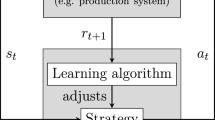Abstract
Production managers employ numerous aggregate planning models to smooth work loads and minimize labor and inventory costs. Some of the more recently developed models incorporate the learning that occurs during repetitive work. This article discusses the history of both aggregate planning and learning models, the various combined models, and their appropriateness to a given environment.
Similar content being viewed by others
References
E.E. Adam, Jr. and R.J. Ebert,Production and Operations Management, 2nd Ed. (Prentice-Hall, Inc., Englewood Cliffs, N.J., 1982).
F.J. Andress, The learning curve as a production tool, Hvd. Bus. Rvw. 32, No. 1 (1954) 87.
D.D. Bedworth and J.E. Bailey,Integrated Production Control Systems (John Wiley & Sons, Inc., 1982).
A.R. Behnezhad and B. Khoshnevis, The effects of manufacturing progress function on machine requirements and aggregate planning problems, TIMS/ORSA, Nov. 1985.
E.H. Bowman, Production scheduling by the transportation method of linear programming, Op. Res. 4 (1956) 100.
J.R. Buck, J.M.A. Tanchoco and A.L. Sweet, Parameter estimation methods for discrete exponential learning curves, AIIE Trans. 8, no. 2 (1976) 184.
J.G.H. Carlson, Cubic learning curves: precision tool for labor estimating, Mfg. Engr. & Mgt. (Nov. 1973) 22.
J.G. Carlson and Alan J. Rowe, How much does forgetting cost?, Industrial Engineering 8, no. 9 (1976) 40.
J.R. Crawford, Statistical accounting procedures in aircraft production, Aero Digest 44 (1944) 78.
E.B. Cochran, New concepts of the learning curve, J. Ind. Engr. 11, no. 4 (1960) 317.
E.B. Cochran,Planning Production Costs: Using the Improvement Curve (Chandler Publishing Company, San Francisco, 1968).
J.R. deJong, The effects of increasing skill on cycle time and its consequences for time standards, Ergonomics 1 (1957) 51.
R.J. Ebert, Time horizon: implications for aggregate scheduling effectiveness, AIIE Trans. 4, no. 4 (1972) 298.
R.J. Ebert, Aggregate planning with learning curve productivity, Mgt. Sci. 23, no. 2 (1976) 171.
S. Globerson, The deviation of actual performance around learning curve models, Int. J. Prod. Res. 22, no. 1 (1984) 51.
J.H. Glover, Manufacturing progress functions I. An alternative model and its comparison with existing functions, Int. J. Prod. Res., 4, no. 4 (1966A) 279.
J.H. Glover, Manufacturing progress functions II. Selection of trainees and control of their progress, Int. J. Prod. Res. 5, no. 1 (1966B) 43.
J.H. Glover, Manufacturing progress functions III. Production control of new products, Int. J. Prod. Res. 6, no. 1 (1967) 15.
F. Hanssmann and S.W. Hess, A linear programming approach to production and employment scheduling, Mgt. Tech. 1, no. 1 (1960) 46.
C.C. Holt, F. Modigliani and H.A. Simon, A linear decision rule for production and employment scheduling, Mgt. Sci. (Oct. 1955).
C.C. Holt, F. Modigliani, J.F. Muth and H.A. Simon,Planning Production, Inventories and Work Force (Prentice-Hall, Inc., Englewood Cliffs, N.J., 1960).
F.C. Jelen and J.H. Black,Cost and Optimization Engineering, 2nd Ed. (McGraw-Hill Book Company, New York, 1983).
L.A. Johnson and D.C. Montgomery,Operations Research in Production Planning, Scheduling and Inventory Control (John Wiley & Sons, Inc., New York, 1974).
C.H. Jones, Parametric production planning, Mgt. Sci. 13, no. 11 (1967) 843.
R.S. Kaplan,Advanced Management Accounting (Prentice-Hall, Inc., Englewood Cliffs, N.J., 1982).
B. Khoshnevis and P.M. Wolfe, An aggregate production planning model incorporating dynamic productivity. Part I. Model development, IIE Trans. 15, no. 2 (1983A) 111.
B. Khoshnevis and P.M. Wolfe, An aggregate production planning model incorporating dynamic productivity. Part II. Solution methodology and analysis, IIE Trans. 15, no. 4 (1983B) 283.
B. Khoshnevis and P.M. Wolfe, A short-cycle product aggregate planning model incorporating improvement curve productivity, Engr. Costs and Prod. Econ. 10 (1986) 217.
G. Nadler and W.D. Smith, Manufacturing progress functions for types of processes, Int. J. Prod. Res. 2, no. 2 (1963) 115.
M.G. Orrbeck, D.R. Schuette and H.E. Thompson, The effect of worker productivity on production smoothing, Mgt. Sci. 14, no. 6 (1968) B-332.
C.C. Pegels, On start-up on learning curves: An expanded view, AIIE Trans. 1, no. 3 (1969) 216.
D. Sahal, A theory of progress functions, AIIE Trans. 11, no. 1 (1979) 23.
G.S. Snoddy, Learning and stability, Applied Psyc. 10 (1926) 1.
W.J. Stevenson,Production / Operations Management (Richard D. Irwin, Inc., Homewod, Ill., 1982).
D.R. Sule, The effect of alternate periods of learning and forgetting on economic manufacturing quantity, AIIE Trans. 10, no. 3 (1978) 38.
D.R. Sule, A note on production time variation in determing EMQ under influence of learning and forgetting, AIIE Trans. 13, no. 1 (1981) 91.
D.R. Sule, Effect of learning and forgetting on economic lot size scheduling problem, Int. J. Prod. Res. 21, no. 5 (1983) 771.
W.H. Taubert, A search decision rule for the aggregate scheduling problem, Mgt. Sci. 14, no. 6 (1968) B-343.
M.S. Titleman, Learning curves — Key to better labor estimates, Product Engineering 29 (1957) 36.
E.A. Tunc and J. Haddock, A model for production and work force planning in long-cycle product environments, Tech. Rpt. 37-87-109, Decision Sci. & Engr. Systems, Rensselaer Polytechnic Inst., Troy, NY 12180-3590 (March 1987).
E.A. Tunc and J. Haddock, An optimization procedure and work force planning in long-cycle product environments, Tech. Rpt. 37-87-110, Decision Sci. & Engr. Systems, Rensselaer Polytechnic Inst., Troy, NY 12180-3590 (March 1987).
P.M. Wolfe, B. Khoshnevis, M.P. Terrell and R. Monjazeb, Aggregate planning models incorporate productivity — an overview, Proc. — 1979 spring annual conf., IIE, Atlanta (1979) 280.
T.P. Wright, Factors affecting the cost of airplanes, J. Aeronautical Sci. 3, no. 2 (1936) 122.
Author information
Authors and Affiliations
Rights and permissions
About this article
Cite this article
Kroll, D.E., Kumar, K.R. The incorporation of learning in production planning models. Ann Oper Res 17, 291–303 (1989). https://doi.org/10.1007/BF02096610
Issue Date:
DOI: https://doi.org/10.1007/BF02096610




